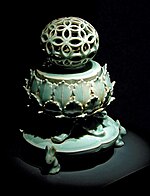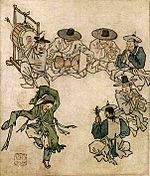National Museum of Korea
| Korean spelling | |
|---|---|
| Korean alphabet : | 국립 중앙 박물관 |
| Hanja : | 國立 中央 博物館 |
| Revised Romanization : | Gungnip Jung-ang Bangmulgwan |
| McCune-Reischauer : | Kungnip Chungang Pangmulgwan |
The Korean National Museum ( English National Museum of Korea , NMK ) is the national museum of South Korea based in Seoul . It represents Korean history and culture . The National Museum was established in 1945 and has created various studies and research activities in the fields of archeology, history and the arts.
history
After the independence of South Korea from the Japanese Empire in 1945 , it took over the previous "Museum of the General Government Chosen" ( Japanese 朝鮮 総 督府 博物館 ) and renamed it on December 3, 1945 in the "National Museum" ( kor. 國立 博物館 ).
During the Korean War , the 20,000 museum pieces were relocated to Busan . When the museum returned to Seoul after the war, they were housed in both Gyeongbokgung and Deoksugung palaces. In 1972 the museum moved to a new building on the grounds of the Gyeongbokgung Palace and was given its current name. The museum moved (accompanied by controversy and criticism) in 1986 again to the former government building of the General Government of Chosens and remained there until the building was demolished in 1995. From December 1996 the museum was temporarily housed in the Social Education Hall.
On October 28, 2005, the National Museum reopened in its new residence in Yongsan Family Park, covering an area of 307,227 square meters (building area: 45,438 square meters).
In 2006, 90 exhibits from the Pyongyang Historical Museum in North Korea were presented in the National Museum of Korea . It was the most important exchange of cultural relics between the two states to date.
Kim Youngna has been a director since February 9, 2011.
investment
The museum is divided into three floors. Symbolically, the left side of the museum is supposed to represent the past, while the right side of the museum represents the future. The museum grounds feature parks, gardens with native plants, waterfalls and pools, and a collection of pagodas, stupas, lanterns and steles (including the National Treasure of Korea No. 2, the great Bosingak bell , modeled on the Korean bells the Joseon period).
On the ground floor is the archaeological exhibition, which contains around 4,500 artifacts excavated in Korea from the Paleolithic to the Silla era. The nine exhibition rooms are dedicated to the Paleolithic, Neolithic, Bronze Age and Gojoseon, the Proto Three Kingdoms Room, the Goguryeo Room, the Baekje Room, the Gaya Room, and Silla. From stone tools, hand axes to luxurious ancient royal ornaments, the relics displayed here depict a long journey taken by early settlers on the peninsula in the development of their own culture. Also on the first floor is the Historical Gallery, which presents the cultural and historical heritage of the Silla, Balhae, Goryeo and Joseon periods in eight rooms.
On the first floor are the Donation Gallery and the Fine Arts Gallery I with 890 works of art that showcase the traditional and religious art of Korea. The Fine Arts Gallery I is divided into four rooms: the Painting Room, the Calligraphy Room, the Buddhist Painting Room, and the Wood-and-Lacquer Room. The Donation Gallery shows 800 works of art donated from private collections.
On the second floor is the Fine Arts Gallery II with 630 pieces representing Korean Buddhist sculpture and handicrafts. Highlights of this gallery are Goryeo Celadon Waren and the "National Treasure of Korea No. 83" Bangasayusang (or Pensive Bodhisattva). The five rooms in this gallery are the Metal Art Room, the Celadon Room, the Buncheong Room, the White Porcelain Room, and the Buddhist Sculpture Room.
Also on the second floor is the Asian Arts Gallery with 970 pieces that reveal the similarities and differences of Asian art and the confluence of Asian and Western art across the Silk Road. The five rooms are the Indian and Southeast Asian Art, Central Asian Art, Chinese Art, Japanese Art, and Sinan Art Rooms .
Exhibits

Gold crown
This Silla gold crown (5th century) comes from the north tomb Hwangnamdaechong in Gyeongju . It is believed that a woman was buried in the north grave because more pieces of jewelry were found there than in the south grave, including a silver belt with the inscription 'Buindae' (women's belt). A golden crown indicates the political and social position of its owner.
Thoughtful bodhisattva
This statue (early 7th century) puts one leg over the other, lost in thought with her fingers on her cheeks. Statues in such a pose were derived from the Buddha's attitude of contemplation on human life. The statue wears a flat crown called the "Three Mountain Crown" or "Lotus Crown". His torso is bare but wears a simple chain. This statue bears remarkable resemblances to the wooden pensive bodhisattva at the Koryuji Temple in Kyoto , which was believed to have been founded by a monk from Silla. In this respect one can assume that this statue comes from the Silla period. On the other hand, because of its balanced shape and elegant and refined craftsmanship, it is also assigned to the Baekje period.

Celadon incense burner
This celadon incense burner (12th century) consists of a lid (with a central hole to let out the incense), a burner and a base. A curved button in the seven-treasure design is cut above the incense hole to distribute the incense.
10-story pagoda from Gyeongcheonsa Temple
The " Gyeongcheonsa Ten-Story Pagoda " (경천사 십층 석탑, 敬 天 寺 十 層 石塔) was originally built in Gyeongcheonsa Monastery in the fourth year (1348) by King Chungmok of Goryeo. It was illegally smuggled into Japan by a Japanese court official in 1907, but was returned in 1918 at the behest of British and American journalists E. Bethell and H. Hulbert. In 1960, it was restored at Gyeongbokgung Palace, but its preservation proved difficult due to acid rain and weathering. So it was dismantled again in 1995 to be housed inside the National Museum of Korea "Path to History" from 2005.
Album of Genre Painting by Danwon, Treasure of Korea No. 527

The painter Kim Hong-do (18th century), also known as Danwon , is known for his humorous and frank paintings about the life of common people. The album on display consists of twenty-five paintings, all of which focus on the characters without a background. Kim's paintings appear sketchy, but they show expressive brushstrokes and balanced compositions. It is believed that Kim started this style of painting in his late thirties and finished the album when he was over 40 years old.
Uigwe
The museum houses 297 volumes of Uigwe , the royal protocols of the Joseon Dynasty . These were looted in 1866 during the French campaign against Korea and remained in the Bibliothèque nationale de France . They were repatriated from April to June 2011, in four separate installments. A special exhibition, The Return of Oegyujanggak Uigwe from France: Records of the Customs of the Joseon Dynasty , was held from July 19 to September 18, 2011.
Web links
Individual evidence
- ↑ Biggest Show of N.Korean Artifacts Comes to Seoul chosun.com on March 28, 2006 (English)
- ^ Lee, Claire, "Ancient Korean royal books welcomed back home," Korea Herald . December 6, 2011
Coordinates: 37 ° 31 '24 " N , 126 ° 58' 46.9" E




